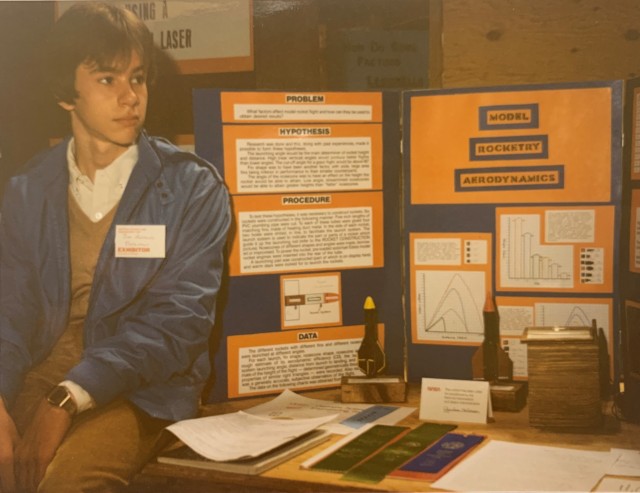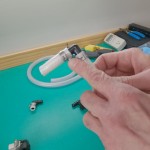This post may contain affiliate links.
We’re big proponents of weighing your RV. It’s a smart safety practice, and it’s not that hard to do. But many RVers find it intimidating, so they don’t do it. We tried to show it was easy by having Stef weigh our RV in an evening gown (yes, that happened), in this video. But even using the app we show, you still have to physically locate a scale and drive your rig to it.
The folks at Curt wanted to come up with a better way to do this (pun very much intended). They approach this with their BetterWeigh device by using Newton’s 2nd Law of Motion, and other measurements to calculate the weight of your rig. It’s a brilliant idea, and I love anything that’s a throwback to high school physics. So I bought one within minutes of finding it on Amazon.
But does it work? I had to know. So when it arrived, I tested it against our nearby CAT scale. The result is this video:
How Does It Work?
If you remember Newton’s 2nd Law, it goes something like this:
Long story short, that boils down to an equation that you can solve for weight (if you assume gravity to be a constant, which, for most RVs, is a pretty solid assumption). Weight is equal to the force on your RV (engine torque, delivered through the wheels), divided by the acceleration of your RV. The torque from your engine, as well as vehicle speed, are available through your rig’s OBDII connection. The BetterWeigh ups the ante here by also having on board acceleration measurement. So, in theory, all the information needed to calculate your vehicle’s weight is available to the BetterWeitgh. It should work!
The Results
I can’t sugar coat this, the results were pretty disappointing. After spending pretty much a whole afternoon with the device, I was never able to get a reported RV weight that was any closer than 660 pounds to Lance’s actual weight. This was in spite of running through the calibration procedure multiple times. And the calibration procedure actually involves telling the app how much your rig weighs!!! So if you consider that the BetterWeigh knew what the RV weighed, and yet still couldn’t tell me what the RV weighed. Well, that’s not good.
The data came out something like this:
| Error | ||
|---|---|---|
| Actual RV Weight | 8740 lbs | 0 |
| First Run (no calibration) | 7400 lbs | -1340 lbs |
| Second Run (no calibration) | 7000 lbs | -1740 lbs |
| Third Run (estimated calibration of 1600 lbs payload) | 9800 lbs | +1060 lbs |
| Fourth Run (same estimated calibration) | 10000 lbs | +1260 lbs |
| Fifth Run (calibration with actual vehicle weight) | 9400 lbs | +660 lbs |
So what theories do I have about why it performed poorly? Well, while Newton’s 2nd works pretty well in the classroom, this was a real-life situation. I tried my best, but it’s likely the torque applied by the engine was not a single, constant value. There were a few times when I felt the RV shift during a run, so that could have been a factor. I can’t really see how the BetterWeigh could account for the rolling resistance of the tires, or the drag forces on the vehicle (though at low speeds, those aren’t that large). And there could have been delays, lags, or dropouts in the data reported to the BetterWeigh through the OBDII port.
I’m going to put in a call to Curt customer service, and see if they have any tips or tricks on getting this thing to work properly. The kid in me who won first prize at the state Science Fair really wanted this thing to work! It’s possible there’s a version 2.0 out there and maybe I just got an older one? I don’t know.
I’d love it if this thing worked out, because then perhaps more people would weigh their RVs and we’d all be safer. If and when they get the bugs worked out, I’ll let you know. But for now, I’d recommend you save your money and spend it instead on a trip to the CAT scale to weigh your RV.

You’ve got to know I would never joke about Science Fair, right? 1984, BABY!!!
PS: The BetterWeigh also had functions for determining trailer weight, tongue weight, etc. I had originally planned to test those, but since I couldn’t get a proper base weight out of the device, we never went there.











Hi, my Nissan Pathfinder weighs around 4800lbs, my empty trailer weighs 2990lbs. Betterweigh consistently tells me the combined weight is 6200lbs and the tongue weight is 600lb (too high I know). If I redistribute some weight to reduce tongue weight down to around 400lb how would that likely affect the combined weight figure? I know I could actually try it but I came home from my tests without doing it and have quite a drive to get back there where it’s quiet enough to do multiple test runs etc! The closest scale is around 80 miles away so I don’t want to go there just yet but am resigned to going there at some point soon. Thanks
I didn’t get into the towing calculations with the BetterWeigh guys.
I know they were watching this post for a while. Perhaps they still are and will chime in.
Hi James,
As a retired IT guy and former mechanical engineer, the one thing I would say is that maybe the road you were on was not level. Sure you started level, but on that 0-15 mph stretch the road may be inclined just a bit. What I would have liked to have seen is the truck weight if you turned around and gone back that stretch. May have helped to figure out the discrepancy.
We’ve got an update video on this technology coming soon! Stay tuned!
I’m in Australia so I need answer in kls please if possible. I’ve bought a motor home that was fitted out privately. How do I know I have the correct weight (installed) in my vehicle? I know the original tare weight of the vehicle before it was modified into a motor home.
The best way to really know the weight of the built out vehicle is to take it and get it weighed. Here in North America, there are drive-on scales at truck stops. Do they have something similar there? Also, places that weigh things by the truckload usually have scales they might let you use (gravel pits, grain elevators, etc.).
kgs = pounds x 2.2
Have you ever compared measuring the footprint of each tire with cardboard and multiplying by tire pressure?
Never really thought about it. I haven’t used a polar planimeter since college.
No, really.
A tire’s footprint is rectangular if you are inflated correctly and on a flat surface. You shove thin pieces of card cardboard (like from a cereal box) from all four sides, tape them together, roll the truck off, and get the surface area. Then multiply by tire pressure.
(Don’t need to worry about the grooves; the air is against the smooth inside of the tire.)
A possible control might be to do with water empty/water full, see if you come up with the correct weight of the water.
But you already know the weight of your rig, so…
Seems a lot easier than your acceleratometer method above.
Also, might be a nice way to get front/back and R/L weight ratios.
-d
You are a very patient person to keep trying for so long. My team of engineers has tested many different vehicles with BetterWeigh. We have used the Promaster before, and while the signal quality wasn’t as good as other vehicles we’ve tested, we got decent results (4% std dev among weigh measurements).
After seeing your video, we found a Travato to try and replicate the failure mode. Our calibrations took 12 launches, and had accuracy similar to what we had seen previous with the Promaster.
Our best theory right now is that there may be an issue with the OBD port. We’ve noticed that the Promaster has a very loose port, the BetterWeigh device may be flopping around on every launch, introducing extra noise into the longitudinal acceleration signal.
We’re happy to discuss further to get to the bottom of this, we have a development app that logs the data, so we can reconstruct things in our lab here in Provo.
Interesting. I had sent an email to Curt right after this video went up.
Are you with Curt? Or did you do the product development or testing? (Let me know if you’d rather take this to email.)
Either way, it could be problematic, as I returned the BetterWeigh after waiting a week.
To your point though – there is play in the OBDII port. It’s not super loose or dangling or anything like that, but there is play. There did not seem to be any way to tighten or lock this down on casual inspection.
I agree that this could cause issues. I could try stuffing rags or foam or something around it, but then I would have to recalibrate every time I reinstalled the BetterWeigh. (I use other OBDII devices as well, so it wouldn’t stay installed permanently.)
That might be fixable with an OBDII splitter and locking down the split ports. But I’d have to lock it down within the parameters the app allows for.
If we make it up to Provo any time soon, we could see if your team is available?
Wonder you guys have ever tried the multiple bathroom scale method of doing individual wheels (google it). I think you need to get about six 400 pound scales to measure each wheel.
Never even considered it.
It’s far too easy to just go to the CAT scale.
Almost $100 for the “Better Weigh”
-or-
$12 for an ACCURATE weight at the Cat Scale.
Tough Decision.
Thanks for saving me from a mistake.
Curt Better-weigh?
Inert, No way!
You won your state science fair! What a claim to fame! And of course it was on rocket science. I’m not sure how, but you made a video about you driving back and forth in a parking lot for a half hour entertaining!
I’m glad it was more entertaining to watch than it was to do!!!
Glad you liked it though. 🙂
had similar experience with the blue tooth brake controller it frustrating and been going back and forth with curt for a long time giving the product benefit of trying to work right always everything but the product no matter how long i work with them . end result still never quite works right connection and app fail time again
Bummer!
I assume you have watched the movie “October Sky”?
One of my favorites…
🙂
Omg James, that hair!
I made it to 17 before I went bald…